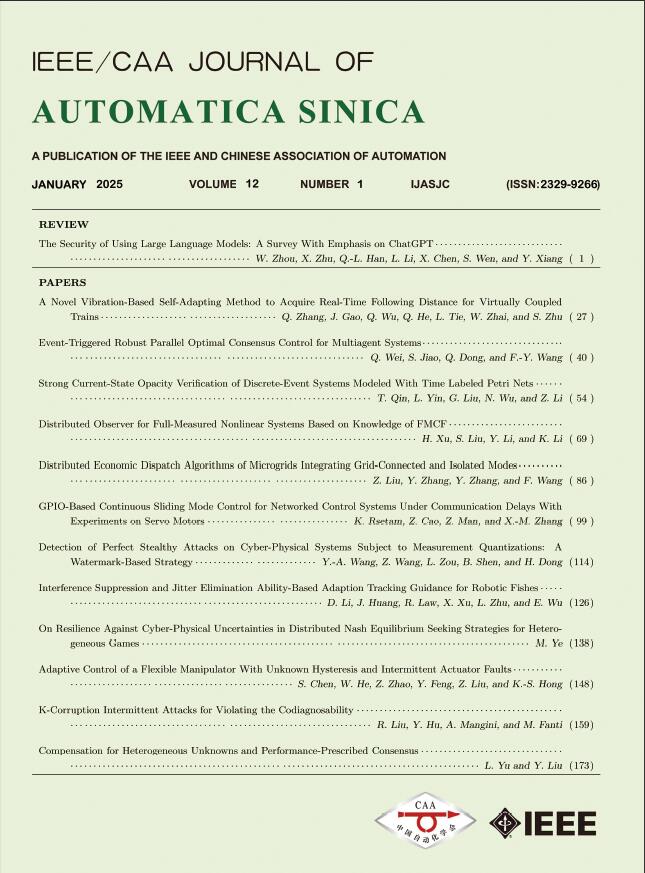 Volume 12
Issue 1
Volume 12
Issue 1
IEEE/CAA Journal of Automatica Sinica
| Citation: | T. Zhan, Y. Ji, Y. Gao, H. Li, and Y. Xia, “Self-triggered impulsive control for nonlinear stochastic systems,” IEEE/CAA J. Autom. Sinica, vol. 12, no. 1, pp. 264–266, Jan. 2025. doi: 10.1109/JAS.2024.124581 |

| [1] |
T. Yang, “Impulsive control theory,” Lect. Not. Contr. Inf. Sci., vol. 272, pp. 1–15, 2001.
|
| [2] |
W. He, Z. Mo, Q.-L. Han, and F. Qian, “Secure impulsive synchronization in Lipschitz-type multi-agent systems subject to deception attacks,” IEEE/CAA J. Autom. Sinica, vol. 7, no. 5, pp. 1326–1334, 2020. doi: 10.1109/JAS.2020.1003297
|
| [3] |
Y. Cui, P. Cheng, and X. Ge, “Exponential synchronization of delayed stochastic complex dynamical networks via hybrid impulsive control,” IEEE/CAA J. Autom. Sinica, vol. 11, no. 3, pp. 785–787, 2024. doi: 10.1109/JAS.2023.123867
|
| [4] |
J. Liu, X. Liu, and W. C. Xie, “Input-to-state stability of impulsive and switching hybrid systems with time-delay,” Automatica, vol. 47, no. 5, pp. 899–908, 2011. doi: 10.1016/j.automatica.2011.01.061
|
| [5] |
C. Du, F. Li, Y. Shi, C. Yang, and W. Gui, “Integral event-triggered attack-resilient control of aircraft-on-ground synergistic turning system with uncertain tire cornering stiffness,” IEEE/CAA J. Autom. Sinica, vol. 10, no. 5, pp. 1276–1287, 2023. doi: 10.1109/JAS.2023.123480
|
| [6] |
M. Yao and G. Wei, “Dynamic event-triggered control of continuous-time systems with random impulses,” IEEE/CAA J. Autom. Sinica, vol. 10, no. 12, pp. 2292–2299, 2023. doi: 10.1109/JAS.2023.123534
|
| [7] |
Z. H. Guan, B. Hu, M. Chi, D. X. He, and X. M. Cheng, “Guaranteed performance consensus in second-order multi-agent systems with hybrid impulsive control,” Automatica, vol. 50, no. 9, pp. 2415–2418, 2014. doi: 10.1016/j.automatica.2014.07.008
|
| [8] |
W. Chen, W. Xu, and W. Zheng, “Sliding-mode-based impulsive control for a class of time-delay systems with input disturbance,” Automatica, vol. 164, p. 111633, 2024. doi: 10.1016/j.automatica.2024.111633
|
| [9] |
W. Zhu, D Wang, L. Liu, and G. Feng, “Event-based impulsive control of continuous-time dynamic systems and its application to synchronization of memristive neural networks,” IEEE Trans. Neural Netw. Learn. Syst., vol. 29, no. 8, pp. 3599–3609, 2017.
|
| [10] |
Z. Hu and X. Mu, “Event-triggered impulsive control for nonlinear stochastic systems,” IEEE Trans. Cybern., vol. 52, no. 8, pp. 7805–7813, 2021.
|
| [11] |
H. Zhou, D Kong, J. H. Park, and W. Li, “Periodic self-triggered impulsive synchronization of hybrid stochastic complex-valued delayed networks,” IEEE Trans. Control Netw. Syst., vol. 11, no. 1, pp. 42–52, 2024. doi: 10.1109/TCNS.2023.3269005
|
| [12] |
X. Tan, C. Xiang, J. Cao, W. Xu, G. Wen, and L. Rutkowski, “Synchronization of neural networks via periodic self-triggered impulsive control and its application in image encryption,” IEEE Trans. Cybern., vol. 52, no. 8, pp. 8246–8257, 2022. doi: 10.1109/TCYB.2021.3049858
|
| [13] |
D. Ding, Z. Tang, Y. Wang, Z. Ji and J. H. Park, “Secure synchronization for cyber-physical complex networks based on self-triggering impulsive control: Static and dynamic method,” IEEE Trans. Netw. Sci. Eng., vol. 8, no. 4, pp. 3167–3178, 2021. doi: 10.1109/TNSE.2021.3106943
|
| [14] |
X. Li and M. Wang, “Stability for nonlinear delay systems: Self-triggered impulsive control,” Automatica, vol. 160, p. 111469, 2024. doi: 10.1016/j.automatica.2023.111469
|
| [15] |
X. Xie, X. Li, S. Song, and X. Liu, “A self-triggered impulsive approach to group consensus of MASs with sensing/actuation delays,” IEEE Trans. Syst. Man Cyber.: Syst., vol. 52, no. 2, pp. 1168–1179, 2024.
|